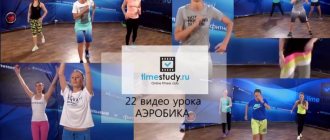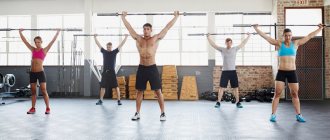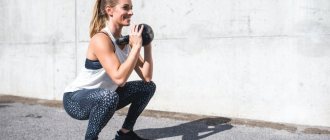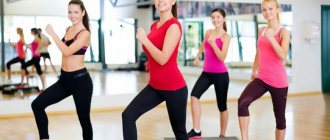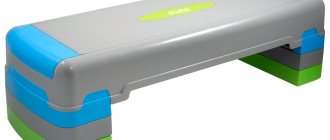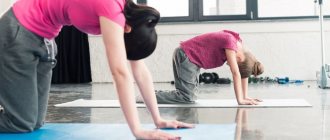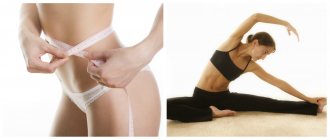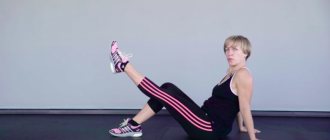Most of us are accustomed to perceiving physical exercise as one type of activity, and mental processes as another. In other words, we are used to distinguishing between mental and physical activity.
But such a direction of fitness as Pilates radically changes this idea. Here, thinking and consciousness are inextricably linked with the movements that the body performs, and thereby ensures complete control and maximum training efficiency.
Pilates connects movement and consciousness
If you strive for perfection, want to improve your figure and well-being, gain self-confidence and grace - this direction was created for you! One of the great advantages of Pilates is that you can do it both in the gym and at home.
Pilates can be done both in the gym and at home.
Another advantage of this area of fitness is the almost complete absence of contraindications and the ability to practice at any age. It doesn’t matter how old you are - fifteen, thirty or sixty-five - you can safely start learning Pilates!
Pilates - classes for everyone
Exercises for beginners are structured in such a way that the load is gentle, but quite effective. It allows you to strengthen your body and get into a routine without creating the risk of injury or exacerbation of a chronic disease.
With regular exercise, you can relieve stress, get rid of obsessive back pain associated with prolonged stay in an uncomfortable body position, and feel pleasant lightness and energy in every cell of your body. Just imagine what prospects will open up before you after your first workout!
With regular exercise, you can relieve stress, get rid of obsessive back pain and feel pleasant lightness and energy.
Pilates training principles:
The main thing is to understand the basic principles:
- “rib” breathing – the inhalation should be directed to the back, to the lower part of the lungs;
- smoothness and continuity of individual elements of the complex - one element flows into another without a sharp transition or pause;
- emphasis on the “center of energy”, that is, the abdominal muscles - they play a key role in performing various exercises;
- concentration in the lesson - complete concentration on performing the exercise, without scattered thoughts and absent-mindedness;
- regularity of training – the recommended frequency of training is five times a week.
General information and main advantages of the program
Initially, a set of Pilates exercises was developed for the accelerated rehabilitation of military soldiers who were wounded in battle. The developer of this program was Joseph Pilates. All exercises included in the training complex contain mandatory muscle stretching movements, which increases the tone and elasticity of all muscle structures.
The most interesting thing is that this gymnastics is an absolutely safe type of training and the likelihood of injury when performing it is minimized.
The effect of training is as follows:
- your posture will become more straight;
- the muscles in the back area will be strengthened;
- the speed of blood flow will increase;
- all joint parts will become stronger.
Pilates can be practiced even during pregnancy, but it is worth considering that despite all the safety of this weight loss method, it has certain contraindications. It is also worth noting that performing the exercises is interconnected with the implementation of the correct respiratory act, which results in improved blood flow and acceleration of metabolic processes in the body. Contraindications to Pilates include severe pain in the muscles and joints and the development of osteoporosis.
Video
Doing Pilates for 60 minutes will help you get rid of 200-250 kilocalories. Undoubtedly, this is not a great result, but in addition, thanks to properly formed breathing and increased physical activity, metabolic processes in the body will be significantly accelerated. All this will allow you to effectively correct your figure and lose weight in all problem areas at the same time. Doing regular exercise will also help reduce your appetite.
Against the background of active development of deep and superficial muscles, the body will constantly need energy, so in the future, the loss of kilocalories will occur not only during training, but also after it.
Benefits of Pilates and disadvantages of classes
Advantages of the technique:
- Strengthens stabilizer muscles, which act as a kind of corset, fixing the normal (physiological) position of the body.
- Develops every aspect of physical fitness: strength, endurance, flexibility, agility, coordination.
- Develops coordination and balance.
- Improves body control.
- Corrects posture.
- Improves the functioning of internal organs.
- Helps in relaxation and stress relief.
- Helps achieve inner harmony through a healthy body.
- Improves diaphragmatic breathing.
- Classes are useful at any age, regardless of gender.
The only drawback that can be noted is that the method will not exceed expectations if you require from training an athletic physique, close to the shape of a bodybuilder or a fitness bikini. There will be no muscle development, as with strength training. The exercises are suitable for rehabilitation after injuries and illnesses, for toning muscles and at the same time relaxing them, but nothing more.
Gluteal bridge
This exercise not only corrects the volume and shape of the buttocks, but also strengthens the lower back, reducing pain, evenly distributing the load on the lumbar region, and also improves walking and running performance. In addition, its main advantage is its variability: you can perform it with your own weight, with a barbell or dumbbells, elastic bands, or with your leg raised up. During the exercise, do not forget about the straight position of the body.
Photo: istockphoto.com
Technique:
- Lie on your back with your legs bent and your heels firmly on the floor.
- Place your hands along your body.
- Lift your hips up as you exhale, hold for a second, lower as you inhale.
Do the exercise 10 times.
Principles
This complex of gymnastic movements includes a number of the following fundamental principles, which create the effectiveness of this program:
- the main principle of this gymnastics is the exercise of constant control over oneself and one’s body; the result of the intensity of strengthening all muscles and improving motor skills depends on the correct execution of movements;
- the connecting link is correct breathing, which consists in working out the performance of the muscles of the respiratory system of the organs;
- An equally important principle is the ability to concentrate on the accuracy of the exercises;
- you also need to correctly find your own center of gravity, which will help to evenly distribute the load on all muscle groups;
- An important point is the smooth execution of movements, due to which the ability to use a certain muscle group at the right moment is formed.
It is worth noting that sudden movements are strictly prohibited; you need to practice calmly and perform all movements very smoothly.
Video: Gymnastics to correct posture and back exercises
A set of exercises for scoliosis, stoop, kyphosis, osteochondrosis
Dear friends!
This page contains a video: Gymnastics to correct posture and exercises for the back. This set of exercises for the back muscles was developed by Dr. Evdokimenko and Lana Paley, author of the book “Better than Yoga,” 20 years ago.
The back exercises from our video can be done at home. All you need to practice is any floor covering on which you will be comfortable practicing. Whether it's a carpet, a blanket or a gymnastics mat. And comfortable clothes, of course.
Our exercises will help you strengthen your back muscles and make your back slimmer. In addition, this back gymnastics helps correct various postural disorders. It is effective for grade 1 or 2 scoliosis, stoop, kyphosis, kyphoscoliosis and Scheuermann's disease.
In addition, our exercises are very useful for the initial stage of ankylosing spondylitis and osteochondrosis of the thoracic spine.
Gymnastics to correct posture and exercises for the back, part 1
Gymnastics to correct posture and exercises for the back, part 2
Gymnastics for the back, part 3. Light version.
How to alternate classes
This page presents 3 sets of exercises for the back. Part 1 and part 2 are the main ones. You can do them in turn - say, on Monday, Wednesday and Friday you do posture exercises, part 1. And on Tuesday, Thursday and Saturday (or Sunday) - part 2. And one day a week, Saturday or Sunday - day off.
Or you can do part 1 and part 2 at once, in one day - but then you need to do it not every day, but every other day.
The 3rd complex is additional, you can do it arbitrarily, regardless of the first 2 complexes. That is, you can perform this complex both daily and every other day. You can perform it together with any of the first two complexes, or do it separately. There are no hard and fast rules in this case - do exercises from the 3rd complex when it is more convenient for you.
About class times. You can do this gymnastics at any time. But it’s still better to do it in the afternoon (12 o’clock). Early in the morning, immediately after sleep, when all the muscles are still “sleeping,” this gymnastics is more difficult. And it brings a little less benefit. But you can do it in the evening! For example, after work or school. Then gymnastics, surprisingly, will add energy to you and breathe new strength into you.
About breathing. Please note that all strength exercises are performed while inhaling. Relaxation occurs as you exhale. Up – inhale, down – exhale.
Nuances. When you do sit-up exercises while lying on your stomach, support your core by tightening the muscles in your mid-back.
Very important! If at first, after doing the exercises, a mild headache or slight pain in the neck appears, this is normal. This is due to tension in the neck muscles that is unusual for the body. To relieve this pain, try a simple neck complex >>
About haste and pain. When doing gymnastics, do not rush. If you want to improve your posture, you will somehow have to learn to perform all the exercises slowly and smoothly, without jerking. A “snatch” effort can only “tear” the back muscles and will bring absolutely no benefit.
Listen to your feelings. If an exercise causes severe pain, give it up completely or reduce its amplitude.
But at the same time, remember that the feeling of aching pain after doing gymnastics is quite acceptable. Aching pain is caused by the inclusion of previously uninvolved muscle groups. And they will disappear after 3-4 weeks of training.
Contraindications to our gymnastics:
These exercises cannot be done: - immediately after operations on the abdominal and chest organs (you need to wait 2-3 months); - for colds and flu, with elevated body temperature; - during pregnancy, especially for a period of 3 months and above; in the first 3 months after birth; - women also need to skip classes on critical days; - for any ACUTE diseases of internal organs - for example, with exacerbation of pancreatitis or cholecystitis, with appendicitis, etc.; - for inguinal hernias; - with severely increased blood pressure, with significantly increased intracranial pressure; - with severe heart damage, severe coronary artery disease; the first 3-6 months after myocardial infarction; with aortic aneurysm; - the first 6 months after a stroke; with severe traumatic brain injuries and immediately after spinal injury; - for severe blood diseases.
Do with caution:
- with paroxysmal tachycardia, with atrial fibrillation; for heart defects; - for hypertension - do it under blood pressure control before and after classes! - with hyperlordosis of the lower back; - for severe intervertebral disc herniations (spinal hernias) - but Schmorl's hernias are not contraindications for gymnastics; - with listhesis - scalene displacements of the vertebrae.
Also, you should not do our exercises during an exacerbation of any illness without first eliminating the acute pain.
This is especially true for acute pain in the neck or lower back. And also in those cases when pain from the neck or lower back along the nerve root shoots into the arm or leg (the so-called radicular syndrome), since performing strength exercises with radicular pain often leads to even greater irritation of the pinched nerve, to increased swelling and inflammation in the nerve sheath trunk
Therefore, before you start doing gymnastics, you must first eliminate the exacerbation of the disease and relieve pain. Only then, having eliminated the exacerbation of the disease, can you slowly begin to do our exercises, but not yet in full, little by little.
And only after making sure that the body does not react to gymnastics with aggravation and intensification of pain, you can perform the exercises in full.
We wish you good health! Dr. Evdokimenko and Lana Paley.
READ MORE:
- Video: Gymnastics for the neck, exercises for the treatment of the cervical spine
- Psychological causes of back pain
- All articles by Dr. Evdokimenko
Equipment and clothing for Pilates
Pilates ball
For a home training set, we can recommend a special Pilates ball as additional equipment; it is small in size and quite light. To avoid changing your exercise technique, where it is possible to hold the ball with both hands, use it as a small weight or as an opportunity to make the exercise unstable. For example, when doing push-ups, when one or two palms are on the ball, hold the ball between the thighs or shins in order to maximize the use of all stabilizers and not lose the ball.
Exercises with a small ball for Pilates in video format:
Isotonic ring for Pilates
Also, an isotonic ring can be used as additional equipment; it can also be used when maintaining balance in exercises and for resistance when squeezing with the hands or the adductor surfaces of the hips.
Pilates ring training in video format:
Roll for Pilates
A set of Pilates exercises with a roll in video format:
Elastic band for Pilates
Pilates training with elastic band in video format:
Pilates clothing
Fitness clothing can be anything, as long as it provides complete freedom of movement.
The most important thing is that a set of Pilates exercises is performed without shoes - barefoot.
